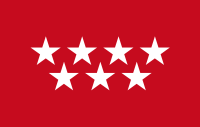Madrilenian parliamentary election, 1991

|
|
|
|
All 101 seats in the Assembly of Madrid
51 seats needed for a majority |
| Registered |
3,827,972  8.9% 8.9% |
| Turnout |
2,251,613 (58.8%)
 11.1 pp 11.1 pp |
| |
First party |
Second party |
| |
.png) |
.jpg) |
| Leader |
Alberto Ruiz-Gallardón |
Joaquín Leguina |
| Party |
PP |
PSOE |
| Leader since |
8 February 1987 |
14 December 1979 |
| Last election |
32 seats, 31.8%[lower-alpha 1] |
40 seats, 38.4% |
| Seats won |
47 |
41 |
| Seat change |
 15 15 |
 1 1 |
| Popular vote |
956,865 |
820,510 |
| Percentage |
42.7% |
36.6% |
| Swing |
 10.9 pp 10.9 pp |
 1.8 pp 1.8 pp |
|
| |
Third party |
Fourth party |
| |
 |
 |
| Leader |
Isabel Villalonga |
José Ramón Lasuén |
| Party |
IU |
CDS |
| Leader since |
1987 |
11 April 1991 |
| Last election |
7 seats, 7.5% |
17 seats, 16.6% |
| Seats won |
13 |
0 |
| Seat change |
 6 6 |
 17 17 |
| Popular vote |
270,558 |
75,081 |
| Percentage |
12.1% |
3.3% |
| Swing |
 4.6 pp 4.6 pp |
 13.3 pp 13.3 pp |
|
|
The 1991 Madrilenian parliamentary election was held on Sunday, 26 May 1991, to elect the 3rd Assembly of Madrid, the regional legislature of the Spanish autonomous community of Madrid. At stake were all seats in the Assembly, determining the President of the Community of Madrid. The number of members increased from 96 to 101 compared to the previous election.
The election saw the electoral collapse of the Democratic and Social Centre (CDS), which fell below the 5% threshold and lost all their 17 seats. Alberto Ruiz-Gallardón's People's Party (PP) emerged as the largest party in the community for the first time,[1] but was unable to form a government due to the lack of allies as a result of CDS expulsion from the Assembly. Consequently, Joaquín Leguina from the Spanish Socialist Workers' Party (PSOE) was re-elected President for a third term in office thanks to the support of United Left (IU).
Electoral system
The number of seats in the regional Assembly was determined by the population count, with 1 seat per each 50,000 inhabitants or fraction greater than 25,000, according to the most updated census data.[2] As the updated population census for the 1991 election was the corresponding to year 1990 (5,028,120), the Assembly size was set to 101 seats.[3]
All Assembly members were elected in a single multi-member district, consisting of the Community's territory (the province of Madrid), using the D'Hondt method and a closed-list proportional representation system. Voting was on the basis of universal suffrage in a secret ballot. Only lists polling above 5% of valid votes (which include blank ballots—for none of the above) in all of the community were entitled to enter the seat distribution.[4]
Background
The 1987 election had resulted in a parliamentary deadlock. The opposition bloc of the People's Alliance (AP) and the CDS held 49 seats against 47 for the PSOE and IU. The ruling PSOE was initially able to hold on to power and have Joaquín Leguina re-elected President thanks to CDS' abstention, but nonetheless the government's majority remained precarious.
In 1988, an AP deputy, Nicolás Piñeiro Cuesta, resigned from the party as a result of ideological differences with the Madrid AP leader, Alberto Ruiz-Gallardón. Piñeiro launched his own party, the Independent Madrilenian Regional Party (PRIM), shortly after. Thereafter, in January 1989, AP along with other parties merged into the newly-created People's Party (PP).
In the first half of 1989, the PP and the CDS reached an agreement of cooperation in the Madrid Assembly, resulting in a motion of no confidence against Leguina's government in June 1989, in an attempt to replace it with a PP-CDS administration headed by Ruiz-Gallardón as Madrid President. To succeed, the motion needed the support of a majority of members, meaning that 49 votes were needed. With the PP and CDS having 48 members, Piñeiro's support was necessary. However, he abstained, and the United Left members blocked the motion alongside PSOE, resulting in the vote failing.[5]
Results
← Summary of the 26 May 1991 Madrid Assembly election results →
| |
| Party |
Vote |
Seats |
| Votes |
% |
±pp |
Won |
+/− |
|
People's Party (PP)[lower-alpha 1] |
956,865 | 42.67 |  10.88 10.88 |
47 |  15 15 |
|
Spanish Socialist Workers' Party (PSOE) |
820,510 | 36.59 |  1.86 1.86 |
41 |  1 1 |
|
United Left (IU) |
270,558 | 12.07 |  4.59 4.59 |
13 |  6 6 |
| |
|
Democratic and Social Centre (CDS) |
75,081 | 3.35 |  13.28 13.28 |
0 |  17 17 |
|
The Greens (LV) |
35,095 | 1.57 |  0.04 0.04 |
0 | ±0 |
|
The Ecologists (LE) |
12,897 | 0.58 | New |
0 | ±0 |
|
Green Union (UVE) |
8,903 | 0.40 | New |
0 | ±0 |
|
Madrilian Independent Regional Party (PRIM) |
7,883 | 0.35 | New |
0 | ±0 |
|
Workers' Socialist Party (PST) |
7,736 | 0.34 | New |
0 | ±0 |
|
Party of Madrid (PAM) |
4,382 | 0.20 | New |
0 | ±0 |
|
Independent Candidatures' Convergence (CCI) |
2,248 | 0.10 | New |
0 | ±0 |
|
Spanish Revolutionary Workers' Party (PORE) |
2,187 | 0.10 | New |
0 | ±0 |
| Parties with less than 0.1% of the vote |
9,127 |
0.41 |
– |
0 |
±0 |
|
Aranjuez Independent Group (AIDA) |
1,899 | 0.08 | New |
0 | ±0 |
|
Alliance for the Republic (AR) |
1,891 | 0.08 | New |
0 | ±0 |
|
Left Platform (PI) |
1,847 | 0.08 | New |
0 | ±0 |
|
United Republican Action (ARU) |
1,346 | 0.06 | New |
0 | ±0 |
|
Madrilenian Centrist Union (UCM) |
1,329 | 0.06 | New |
0 | ±0 |
|
Generational Integration (IG) |
815 | 0.04 | New |
0 | ±0 |
|
Blank ballots |
28,872 | 1.29 |  0.45 0.45 |
|
| |
| Total |
2,242,344 | 100.00 | |
101 |  5 5 |
| |
| Valid votes |
2,242,344 | 99.59 |  0.81 0.81 |
|
| Invalid votes |
9,269 | 0.41 |  0.81 0.81 |
| Votes cast / turnout |
2,251,613 | 58.82 |  11.05 11.05 |
| Abstentions |
1,576,359 | 41.18 |  11.05 11.05 |
| Registered voters |
3,827,972 | |
| |
| Source: Argos Information Portal |
| Vote share |
|---|
|
|
|
|
|
| PP |
|
42.67% |
| PSOE |
|
36.59% |
| IU |
|
12.07% |
| CDS |
|
3.35% |
| LV |
|
1.57% |
| Others |
|
2.46% |
| Blank ballots |
|
1.29% |
| Parliamentary seats |
|---|
|
|
|
|
|
| PP |
|
46.53% |
| PSOE |
|
40.59% |
| IU |
|
12.87% |
Notes
References
.png)
.jpg)

